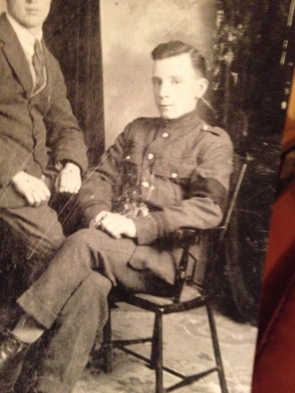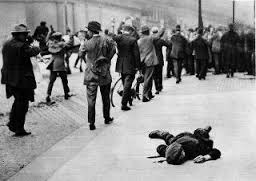Walking to Work Through a Battle Zone
There are two routes I can take to my office when I leave the train station to go to work. They both pass a large 18th century building of Palladian, neoclassical design, which I used to admire as a child, long before I knew of its connection to my own family.
Now, as I pass it by, I study its pillars and façade for signs of bullet holes and shrapnel scars, and I imagine the men who died there.
I can almost hear the crack of gunfire, the screams of anger, pain, defiance, and the sight of red-gold flames flashing beneath billowing black-grey smoke.
My nostrils twitch at the imagined smell of cordite, and I wonder what my grandfather Michael’s role was when, aged just 20, he and scores of other IRA men in the Dublin Brigade attacked the Custom House in May 1921, on what would turn out to be the most disastrous raid in IRA history.
Above, the Custom House
At lunchtime on May 25, small groups of IRA men had gathered in the area surrounding the Custom House – a symbol of British rule in Ireland. There were about 120 IRA men in total, many of them inexperienced fighters. Although that could not be said of my own grandfather Michael.
By that stage of the War of Independence he was something of a veteran, having joined up in 1919. Michael was a member of the Active Service Unit (ASU) of the Dublin Brigade.
That day, the ASU had been issued with revolvers (six rounds per man) and hand grenades. Their job was to position themselves beneath the Butt Bridge railway line, running beside the Custom House, and act as a protective force in the event of British troops arriving on the scene. The rest of the men were to enter the building and set it on fire using tins of petrol.
At one o’clock, the attack began. The first casualty was an elderly caretaker, who was gunned down as he tried to telephone for help. IRA men herded civilians together and set about torching the rooms.
Auxiliaries and several hundred British troops soon arrived to surround the building, and a heavy firefight ensued. Michael’s unit managed to hold them off for about half an hour, but with just six bullets each against machine-guns, the result was inevitable. An official statement issued by Dublin Castle later described the attack…
“Three tenders carrying Auxiliary Cadets, accompanied by an armoured car, approached the Dublin Customs House, which was occupied by a large body of Sinn Feiners. The Cadets dismounted from their tenders under heavy fire and surrounded the Customs House, which was seen to be on fire. Fire from the Auxiliaries and the machine-guns on the armoured car was poured into the windows of the Customs House, from which the rebels replied vigorously, and a series of desperate conflicts took place between Crown forces and seven or eight parties of rebels, who rushed from different doors of the building and made dashes for liberty, firing as they ran. The first party to emerge from the building consisted of three men, one of whom was killed and two wounded.
By this time smoke and flame were pouring from the building, and the official staff, including many women, who had been held prisoners by the rebels, came flocking out with their hands above their heads and waving white handkerchiefs. While these defenseless people were leaving the building the rebels continued to fire from the windows. The staff were taken to a place of safety by some of the Auxiliaries.
As the staff were leaving the building the rebels made their last sortie, and of this party, consisting of seven men, only one escaped, the rest being killed or wounded. Some of the Auxiliaries then stormed the blazing building, where many of the rebels surrendered. Some of them were found to be saturated with petrol which they had been pouring over the flames, and several of them were probably burnt to death before the Crown forces entered….at the conclusion of the fighting dead and wounded rebels lay about on all sides…Four Auxiliaries were wounded, 7 civilians were killed, 11 wounded, and over 100 captured.”

Michael Lawlor
Despite the Dublin Castle statement, it would emerge that five IRA men were killed, as were three civilians. The British forces suffered four wounded. The greatest loss, though, was in the capture of 80 volunteers at the scene.
Michael was lucky to get out of there in one piece.
The same could not be said of the Custom House. It was gutted, with documents stretching back hundreds of years destroyed in the conflagration. In time, it was restored, and carries its scars to this day.
The attack was a stunt that the hard-pressed IRA, struggling in terms of manpower and resources, could ill afford. The operation was an unnecessary disaster -- the truce would come less than two weeks later, bringing an official end to fighting.
Now, as I walk beneath Butt Bridge on my way to work -- the same bridge where grandad fought – the hairs on my arms and neck bristle. Where, precisely, had he stood? Did he shoot anyone … injure anyone with a well-lobbed grenade?
I think of him … think of his youth and his bravery, and then wonder how I would have fared standing in his shoes.
The ghosts of that day still linger, their barely-heard echo masked amongst the sounds of rush-hour traffic and smothered by our own rush-hour lives.
If you pause and listen carefully, though, you might just hear them because the past is ever present and it wants its stories told, wants them to be read on buildings like those shrapnel-scarred, bullet-pocked walls that I walk by every day.
We should always seek out the clues to our past. The stories waiting to be discovered tell us more about ourselves than we’d have ever thought possible.
LINKS:
MORE ON THE IRISH WAR OF INDEPENDENCE
Irish Rebel Maurice Meade: May You Live in Interesting Times
"The Blacksmith" Hammers the Auxies at Clonfin, Longford
Dillon’s Cross Ambush and the Burning of Cork City
Corkmen Capture Mallow Barracks
Ballymahon Barracks Attack: Arming the Boys of Longford
The Listowel Mutiny: “Shoot on Sight”
The Ballymacandy Ambush: "I would not turn off my road for any Shin...
Seán Treacy at War: Tipperary 'Far Away'
“Paddy” O’Brien and the Rathcoole ambush: Vengeance Is “Mine”
The Scramogue Ambush: Roscommon Steps Up
The 1st Brigade Cork Volunteers and the Coolnacahera Ambush
Michael Brennan and the East Clare Brigade at the Glenwood Ambush
100 Years Ago: The Piltown Ambush (1 November 1920)
Liam Lynch, Civil War Martyr: “It never should have happened”
“Tipperary’s Dan Breen: The Hardest Hard Man.”
'Greyhound on Train': Rescuing Seán Hogan at Knocklong
The Clonbanin Ambush: “To Hell With Surrender!”
George Lennon: Waterford Rebel
George Lennon & the Piltown Ambush
The Kilmallock Barracks Attack: Burning Down the House in Limerick
The Tureengarriffe Ambush: Cork & Kerry Strike a Blow
The Tourmakeady Ambush: Shrouded By the “Fog of War” in Mayo
The Headford Ambush: Time Runs Out in Kerry
Cataclysm in Cork: The Battle of Clonmult
“The Scourge of Tralee”: Stalking the “The Major”
The Dromkeen Ambush: Down Into the Mire in County Limerick
The Rineen Ambush: Hell Comes to County Clare
The Carrowkennedy Ambush, June 2, 1921: Revenge is a Dish Best Serv...
Tom Barry: 'We May Have Great Men, But We’ll Never Have Better'
The Battle of Crossbarry: ... 'Who Piped Old Ireland Free'
The Kilmeena Ambush, May 19, 1921: Seeds of Victory in a Defeat
'Nigh Comeragh's Rugged Hills': Ambush at The Burgery
The R.I.C. In An Untenable Position, Part 1: Trauma at The Burgery
The Lispole Ambush -- Averting Disaster on the Dingle Peninsula
Patrick White: A Clareman's Tragic Death on Spike Island
'And To Watch the Sunbeams Dancing O’er the Wicklow Mountains High'
Always Remember ~ Cumann na mBan
War of Independence -- How the Nuns of Kylemore Saved My Father's Life
Terence MacSwiney: Irish Martyr
Walking to Work Through a Battle Zone
Review of 'Emmet Dalton - Somme Soldier, Irish General, Film Pionee...
Ballinalee, County Longford: The Village of Generals
The Anglo-Irish Treaty: Seed of 'The Troubles'
Shot While Attempting To Escape
Easter Rising to Irish Civil War Archive Available Online
Michael Collins: Saga of Heroism Against Daunting Odds
A Short History of Michael Collins, Ireland's 'Big Fellow'
Great Irish Romances: Michael Collins and Kitty Kiernan
Kitty and Michael: a revolutionary courtship
The Tan Who Was Hanged By His Own Side
Liam Lynch: Victim of the Irish Civil War
After The Rising … 'Fron-goch and the Birth of the IRA'
Ernie O'Malley: Mayo-Born Freedom Fighter and Writer
The Wild Geese Virtual Síbín with Cormac O'Malley
Evidence Abounds: British Leaders OK'd Mayhem
The West Cork Trail: Scenes From the Anglo-Irish and Civil Wars, 19...
How I Learned That Grandad Executed Erskine Childers
Leaders of the 1916 Easter Rising: Éamon de Valera
Erskine Childers: Author, Irish Gunrunner, Churchill's Bête Noire
The Scum of England, or Ordinary Men? A Review of DJ Kelly's 'Runni...
The Forgotten Ten:
-
Heritage Partner Comment by That's Just How It Was on June 10, 2016 at 1:36pm -
As always David a story told brilliantly... That it is a personal story , just adds that little bit of magic.. I bet he woudl be proud of his Grandson, a Journalist , telling his tale,,, I reda you articles like I read JAB ... it flows beautiful
-
Comment by David Lawlor on June 10, 2016 at 7:23pm
-
Thanks Mary, that's really nice of you to say. I'm glad you like the posts
-
Comment by Jean Sullivan Cardinal on June 12, 2016 at 4:50pm
-
Wonderful, love hearing these stories!
-
Comment by David Lawlor on June 12, 2016 at 6:33pm
-
Thanks Jean. I'm glad you liked it.
-
Comment by Mairead Geary on June 19, 2016 at 1:03pm
-
Beautiful piece. Thanks for sharing your family's story and connection to the Rising. I love how you said ... "The ghosts of that day still linger, their barely-heard echo masked amongst the sounds of rush-hour traffic and smothered by our own rush-hour lives." But thanks to writers like you, those echoes are still being heard.
-
Comment by David Lawlor on June 19, 2016 at 2:30pm
-
Thanks for the kind words, Mairead, I'm glad you liked it.
-
Comment by Jillian Godsil on June 21, 2016 at 12:18pm
-
Thought you might like this story of 1916... http://jilliangodsil.com/index.php/homes-for-the-dead-1916-holden-s...
Comment
The Wild Geese Shop
Get your Wild Geese merch here ... shirts, hats, sweatshirts, mugs, and more at The Wild Geese Shop.
Irish Heritage Partnership
Adverts
Extend your reach with The Wild Geese Irish Heritage Partnership.
Top Content
Videos
© 2025 Created by Gerry Regan.
Powered by
![]()
Badges | Report an Issue | Privacy Policy | Terms of Service

You need to be a member of The Wild Geese to add comments!
Join The Wild Geese